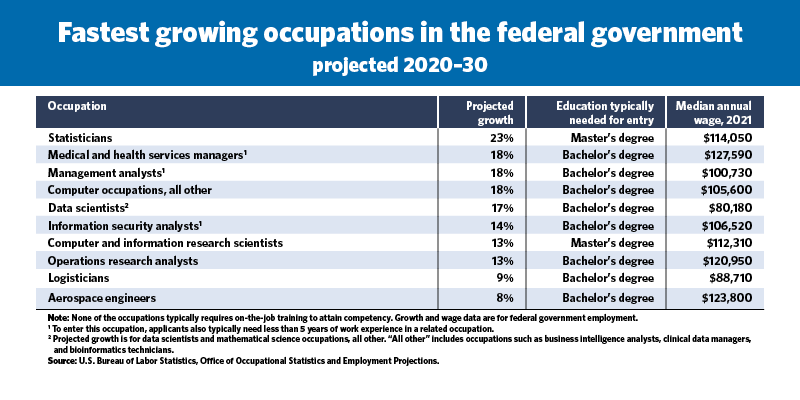Public Service Recognition Week is an annual observance that honors the people who serve our nation as federal, state, county, local and tribal government employees. This year, to celebrate Public Service Recognition Week, we’re recognizing the hardworking people who make up our federal workforce and looking to federal workers of the future. Which occupations in the federal government are projected to have the fastest employment growth from 2020 to 2030? According to data produced by federal workers at the U.S. Bureau of Labor Statistics, most of the occupations are related to information technology or math.
Employment in some occupations is projected to increase by 2030, despite an expected decline of 2% in federal employment overall. In fact, as the table shows, federal employment in occupations that focus on IT or math is projected to grow faster than the 8% average for occupations across all industries from 2020 to 2030. And each of these occupations had a median annual wage greater than the $71,120 median annual wage for all workers in the federal government in 2021.

Two occupations in the table typically require a master’s degree for entry: Statisticians, projected to have the fastest federal employment growth (23%) among those shown, apply statistical methods to collect, organize and interpret data. Computer and information research scientists design innovative uses for new and existing computing technology.
The remaining occupations shown in the table typically require a bachelor’s degree, with three also needing related work experience.
Medical and health services managers plan, direct and coordinate the business activities of healthcare providers. Applicants for federal jobs may need experience developing, evaluating, and adjusting administrative services.
Management analysts recommend ways to improve an organization’s efficiency. The experience they need for a federal position may include developing cost analyses of projects or of current or projected programs.
Computer occupations, all other includes web administrators, digital forensics analysts and document management specialists. Job duties vary by position. For example, some federal workers collect and analyze Internet services usage and performance statistics.
Data scientists extract meaningful information and insights from large data sets. Applicants for federal jobs may need knowledge, skills or abilities related to areas such as artificial intelligence, big data principles and data visualization.
Information security analysts plan and carry out security measures to protect an organization’s computer networks and systems. For federal jobs, applicants may need experience formulating program initiatives in response to critical IT security issues.
Operations research analysts use math and logic to help solve complex problems. In federal jobs, they may design, develop, and maintain systems.
Logisticians analyze and coordinate an organization’s supply chain. Logisticians working for federal agencies may need to monitor the progress of a specific plan and identify the cause and impact of delays or other problems.
Aerospace engineers design aircraft, spacecraft, satellites and missiles. Federally employed aerospace engineers may develop, analyze and lead operations for mission scenarios and flight systems.
The federal government employs workers in about 350 occupations, according to BLS. Visit the Occupational Outlook Handbook to learn about the job duties, education requirements, wages and more for the occupations highlighted here, as well as hundreds of others. Applicants to federal jobs may need specialized skills or experience. Requirements are specified in USAJobs postings and in the U.S. Office of Personnel Management standards for selected occupations.
Ryan Farrell and Maria Hussain are economists in the U.S. Bureau of Labor Statistics. Follow BLS on Twitter at @BLS_gov.
Fastest growing occupations employed by the federal government, projected 2020–30
Occupation | Employment growth in federal government, projected 2020–30 | Education typically needed for entry | Median annual wage in federal government, 2021 |
| Statisticians | 23% | Master's degree | $114,050 |
| Medical and health services managers1 | 18% | Bachelor's degree | $127,590 |
| Management analysts1 | 18% | Bachelor's degree | $100,730 |
| Computer occupations, all other | 18% | Bachelor's degree | $105,600 |
| Data scientists2 | 17% | Bachelor's degree | $80,180 |
| Information security analysts1 | 14% | Bachelor's degree | $106,520 |
| Computer and information research scientists | 13% | Master's degree | $112,310 |
| Operations research analysts | 13% | Bachelor's degree | $120,950 |
| Logisticians | 9% | Bachelor's degree | $88,710 |
| Aerospace engineers | 8% | Bachelor's degree | $123,800 |
Note: None of the occupations typically requires on-the-job training to attain competency. 1 To enter this occupation, applicants also typically need less than 5 years of work experience in a related occupation. 2 Projected growth is for data scientists and mathematical science occupations, all other. "All other" includes occupations such as business intelligence analysts, clinical data managers, and bioinformatics technicians. Source: U.S. Bureau of Labor Statistics, Office of Occupational Statistics and Employment Projections. | |||

 U.S. Department of Labor Blog
U.S. Department of Labor Blog